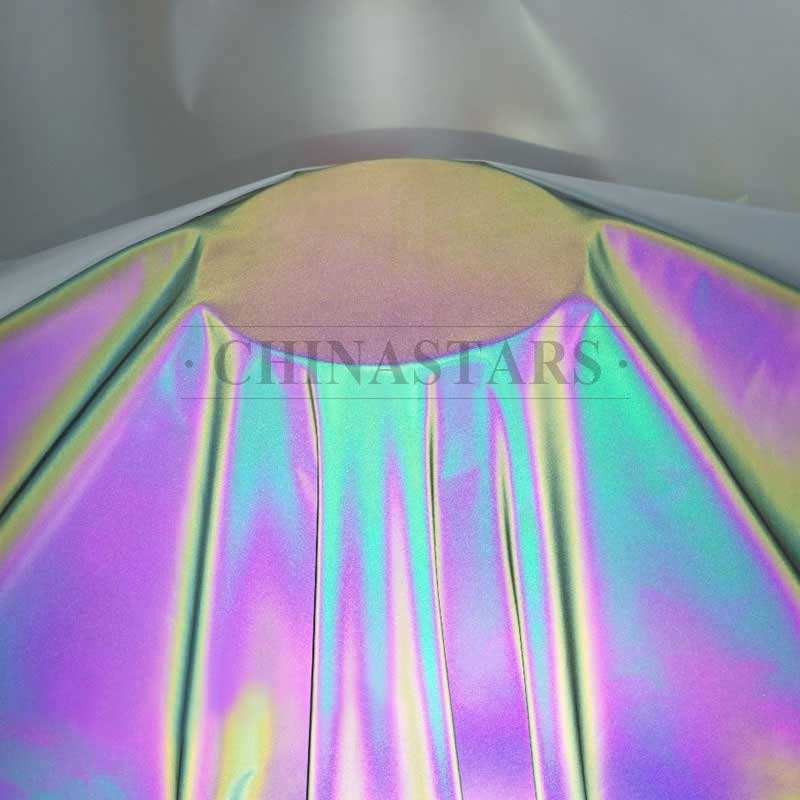How to See Reflective Fabric: Test Reflective Effects with Flashlight or Smartphone
"Reflective fabric plays a vital role in enhancing visibility and personal safety, especially in low-light or nighttime environments. It is widely used in high-visibility clothing, sportswear, outdoor gear, and occupational safety equipment. But how exactly can you observe and verify its reflective performance?"
This guide offers a step-by-step explanation on how to observe reflective fabric using a flashlight or smartphone and how to maintain its reflective performance over time.

What Is Reflective Fabric?
Reflective fabric is a specialized material made by coating a base fabric (such as polyester, cotton, or aramid) with retroreflective elements—usually tiny glass beads. These elements reflect light back toward its original source, a phenomenon known as retroreflection.
When exposed to a directed light source—such as vehicle headlights or a camera flash—the fabric appears to glow brightly, significantly improving visibility in the dark.
How to Observe Reflective Fabric: Step-by-Step Guide
Step 1: Choose an Appropriate Environment
Reflective performance should be tested in controlled, low-light conditions. Recommended environments include:
- A dark room or enclosed indoor space at night
- Outdoors at night or in shaded environments without ambient light
- Avoid brightly lit rooms or daylight testing, as ambient light can reduce visibility of reflective effects

Step 2: Select a Suitable Light Source
For accurate observation, the light source should emit focused and direct light. The most effective tools include:
- LED flashlight
- Smartphone flashlight
- Camera flash
Step 3: Set the Correct Viewing Distance and Angle
Reflective materials only return light to the direction it came from, so the observer position is critical:
- Distance: Maintain a distance of 1.5 to 3 meters (5 to 10 feet) from the fabric
- Angle: Hold the light source as close to your eye level as possible, pointing it directly at the fabric
- This simulates real-world conditions, such as headlights aligned with a driver’s eye level hitting a reflective vest
Step 4: Observe and Evaluate the Reflective Effect
Shine the light directly at the fabric and observe:
- Contrast: Reflective areas should appear significantly brighter than surrounding material
- Sharpness: High-quality reflective fabric will reflect light in a sharp, well-defined area
- Coverage: Note how much of the surface is reflective and how evenly it reflects
For more consistent evaluation, take a photo using a camera or smartphone flash and compare the brightness in captured images.
How to Use Your Smartphone to Test Reflective Fabric
Smartphones provide two convenient methods for testing:
1. Flashlight Method
- Turn on the built-in flashlight
- Stand about 1.5–2 meters away
- Direct the flashlight beam at the fabric from eye level
- Look along the line of light to see the reflection returning
2. Camera Flash Method
- Open the camera app and enable flash
- Frame the reflective fabric from a distance of 1.5–2 meters
- Take a photo — the reflective effect should be visible in the image as a bright glow
- This method is especially useful for documenting reflective performance
3. Flash Video Method
- Switch to video mode and enable flash
- Record while moving the fabric or phone slightly
- This helps observe how the reflection changes with movement and angle, useful for garments in motion
For a visual demonstration of these methods, you can refer to the following video:
This video provides practical examples of testing reflective fabric using common devices, which can be beneficial for both personal and professional applications.
If you need further assistance or additional resources on reflective materials, feel free to ask!
Applications
Here are a few common scenarios where reflective fabric proves its worth:
Safety Clothing
Reflective fabric is widely used in safety clothing for construction workers, emergency responders, and road maintenance crews. Observing reflective tape on a safety vest or jacket under headlights at night demonstrates its effectiveness.
Sportswear
Sportswear, particularly for runners and cyclists, often incorporates reflective tapes. Testing these garments with a flashlight during an evening run can highlight the increased visibility reflective fabric provides.
Safety Gear
Camping gear, backpacks, and outdoor accessories often include reflective materials to enhance visibility in low-light conditions. Using a flashlight to illuminate these items in the dark can show how they help locate individuals and equipment.
Learn More About Reflective Fabrics and Applications
We offer a full range of reflective materials, including silver, color, rainbow, pattern printing, and glow in the dark reflective fabrics for apparel and gear. To explore all categories and applications:
How to Maintain Reflective Fabric
Reflective fabrics are technical materials that require correct care to maintain their reflective brightness and durability:
1. Washing Guidelines
- Follow the care label strictly
- Use mild detergent, avoid bleach, softeners, or high-alkaline cleaners
- Wash in cold or lukewarm water (preferably ≤40°C or 104°F)
- Turn garments inside out during washing to reduce abrasion
2. Drying and Heat Exposure
- Air dry when possible
- Do not iron directly on reflective areas
- Avoid exposure to direct high heat (e.g., dryers exceeding 75°C / 167°F)
3. Inspection and Replacement
Regularly check for:
- Peeling
- Cracks
- Fading
- Loss of reflectivity
Replace items that show significant wear or diminished reflection
4. Storage Recommendations
- Store in dry, dark conditions
- Avoid prolonged exposure to UV rays or high humidity
- Keep reflective garments flat or loosely folded to avoid creasing
Conclusion
Seeing reflective fabric in action is both simple and impressive. By understanding how it works and using the right methods to observe its reflective properties, you can appreciate the vital role it plays in enhancing safety and visibility. Whether you’re a professional needing reliable safety gear or an outdoor enthusiast wanting extra visibility, the reflective fabric is an essential material that helps you stay seen and safe. Using your smartphone, you can easily test and appreciate the effectiveness of reflective fabric in various conditions.




